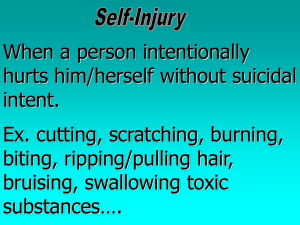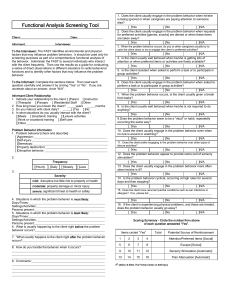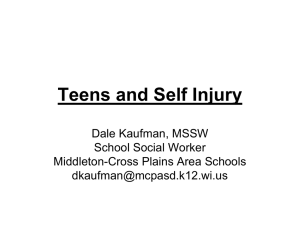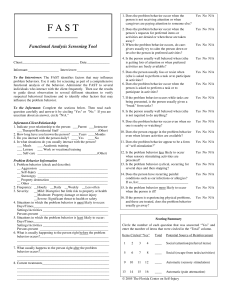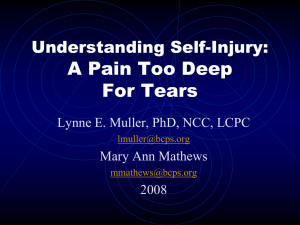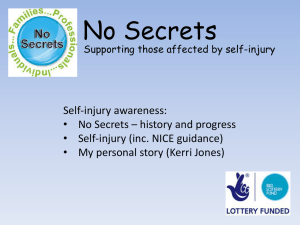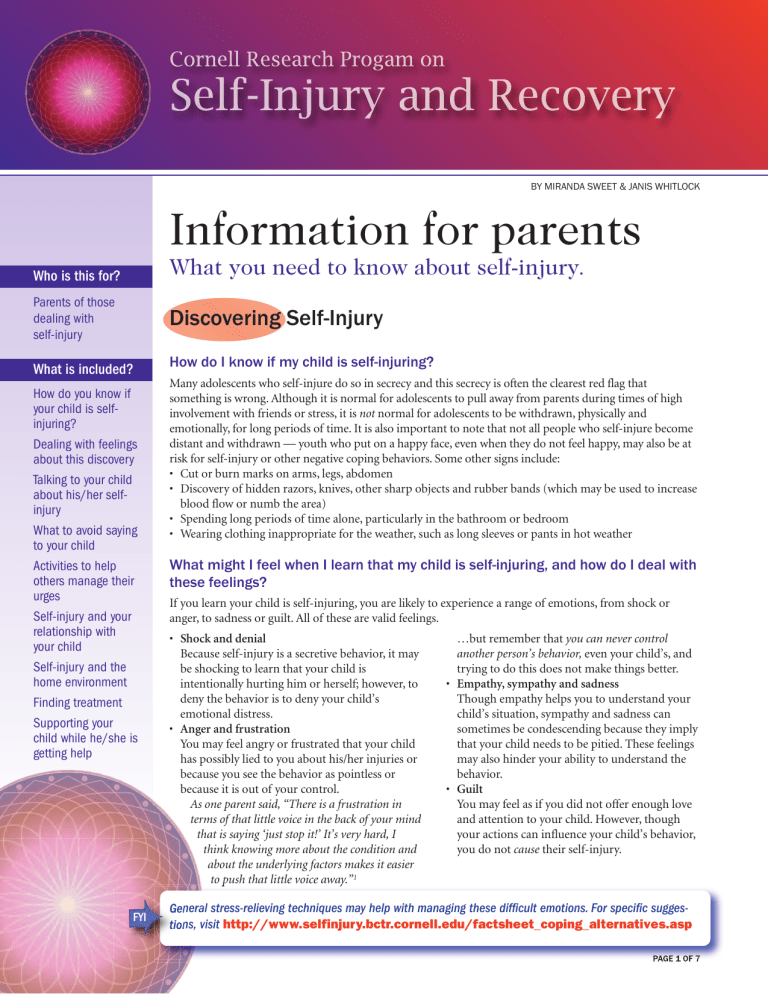
By Miranda Sweet & JaniS whitlock Information for parents What you need to know about self-injury. Who is this for? Parents of those dealing with self-injury Discovering Self-Injury What is included? How do you know if your child is selfinjuring? Dealing with feelings about this discovery Talking to your child about his/her selfinjury What to avoid saying to your child Activities to help others manage their urges Self-injury and your relationship with your child Self-injury and the home environment Finding treatment Supporting your child while he/she is getting help FYI How do I know if my child is self-injuring? Many adolescents who self-injure do so in secrecy and this secrecy is often the clearest red flag that something is wrong. Although it is normal for adolescents to pull away from parents during times of high involvement with friends or stress, it is not normal for adolescents to be withdrawn, physically and emotionally, for long periods of time. It is also important to note that not all people who self-injure become distant and withdrawn — youth who put on a happy face, even when they do not feel happy, may also be at risk for self-injury or other negative coping behaviors. Some other signs include: • Cut or burn marks on arms, legs, abdomen • Discovery of hidden razors, knives, other sharp objects and rubber bands (which may be used to increase blood flow or numb the area) • Spending long periods of time alone, particularly in the bathroom or bedroom • Wearing clothing inappropriate for the weather, such as long sleeves or pants in hot weather What might I feel when I learn that my child is self-injuring, and how do I deal with these feelings? If you learn your child is self-injuring, you are likely to experience a range of emotions, from shock or anger, to sadness or guilt. All of these are valid feelings. • Shock and denial Because self-injury is a secretive behavior, it may be shocking to learn that your child is intentionally hurting him or herself; however, to deny the behavior is to deny your child’s emotional distress. • Anger and frustration You may feel angry or frustrated that your child has possibly lied to you about his/her injuries or because you see the behavior as pointless or because it is out of your control. As one parent said, “There is a frustration in terms of that little voice in the back of your mind that is saying ‘just stop it!’ It’s very hard, I think knowing more about the condition and about the underlying factors makes it easier to push that little voice away.”1 …but remember that you can never control another person’s behavior, even your child’s, and trying to do this does not make things better. • Empathy, sympathy and sadness Though empathy helps you to understand your child’s situation, sympathy and sadness can sometimes be condescending because they imply that your child needs to be pitied. These feelings may also hinder your ability to understand the behavior. • Guilt You may feel as if you did not offer enough love and attention to your child. However, though your actions can influence your child’s behavior, you do not cause their self-injury. General stress-relieving techniques may help with managing these difficult emotions. For specific suggestions, visit http://www.selfinjury.bctr.cornell.edu/factsheet_coping_alternatives.asp PAGE 1 of 7 opening the Lines of Communication How should I talk to my child about his/her self-injury? • Address the issue as soon as possible. Don’t presume that your child will simply “outgrow” the behavior and that it will go away on its own. (Though keep in mind this can and does happen for some young people–some do mention “outgrowing” their self-injury. This typically occurs because they learn more adaptive ways of coping). • Try to use your concern in a constructive way, by helping your child realize the impact of his/her self-injury on themselves and others. • It is most important to validate your child’s feelings. Remember that this is different from validating the behavior. – Parents must first make eye contact and be respectful listeners before offering their opinion – Speak in calm and comforting tones – Offer reassurance – Consider what was helpful to you as an adolescent when experiencing emotional distress • If your child does not want to talk, do not pressure him/her. Self-injury is a very emotional subject and the behavior itself is often an indication that your child has difficulty verbalizing his/her emotions. What are some helpful questions I can ask my child to better understand his/her self-injury?2 Recognize that direct questions may feel invasive and frightening at first—particularly when coming from someone known and cared for, like you. It is most productive to focus first on helping your child to acknowledge the problem and the need for help. Here are some examples of what you might say: • “How do you feel before you self-injure? How do you feel after you self-injure?” Retrace the steps leading up to an incident of self-injury—the events, thoughts, and feelings which led to it. • “How does self-injury help you feel better?” • “What is it like for you to talk with me about hurting yourself?” • “Is there anything that is really stressing you out right now that I can help you with?” • “Is there anything missing in our relationship, that if it were present, would make a difference?” • “If you don’t wish to talk to me about this now, I understand. I just want you to know that I am here for you when you decide you are ready to talk. Is it okay if I check in with you about this or would you prefer to come to me?” “…internal pain wasn’t real and wasn’t something you that you could heal. And if you make it external, it’s real, you can see it… I needed to have it be in a place other than inside me.” —Interviewee What are some things I should AvoID saying or doing? The following behaviors can actually increase your child’s self-injury behaviors:3 • Yelling • Lecturing • Put downs • Harsh and lengthy punishments • Invasions of privacy (i.e., going through your child’s bedroom without his/her presence) • Ultimatums • Threats Avoid power struggles. You cannot control another person’s behavior and demanding that your loved one stop self-injuring is generally unproductive. The following statements are examples of unhelpful things to say: • “I know how you feel.” This can make your child feel as if their problems are trivialized. • “How can you be so crazy to do this to yourself?” • “You are doing this to make me feel guilty.” Take your child seriously. One individual who struggles with self-injury described her disclosure to her parents in the following way: "They freaked and made me promise not to do it again. I said yes just to make them feel better though. That settled everything for them. I felt hurt that they did not take me serious[ly] and get me help.”4 PAGE 2 of 7 How do I know if I am doing or saying the right thing? • Parents need to ask for feedback from their child about how well they are doing their job as parents. – This demonstrates that they are truly engaged in improving and strengthening their relationship with their child. – Parents can identify specifically what they can do to contribute to their child’s success. Are there any activities I can complete with my child to help them manage their urges to self-injure? The Nillumbik Community Health Service has developed an activity for identifying who can be helpers and specifically how they can help. There is a worksheet to fill in who is available at different times throughout the day for support. To link to this worksheet, see http://www.nchs.org.au/Docs/SelfHarm_StuInfoPack.pdf. If your child has already developed a list of effective coping strategies for managing distress (for more on this, see http://www.selfinjury.bctr.cornell.edu/factsheet_coping_ alternatives.asp), this information can be put together to create a “help card,” which includes your child’s top coping strategies and phone numbers of support people, and can be easily carried around in a wallet for whenever the need for support may arise. Go to Appendix M of http://www.sfys.infoxchange.net.au/resources/public/items/2004/12/00131-upload-00001.doc to link to the help card activity. “Parents, there is hope. If you are facing some of the difficulties we have… don’t give up. You need to fight; many teachers, doctors and counselors may not have the knowledge or ability to help — keep fighting. Don’t give up; there can be a bright light at the end of the tunnel.” — Parent collaborators on CRPSIR team FYI To read more about the personal experiences of these parents, see http://www.selfinjury.bctr.cornell.edu/factsheet_personal_stories.asp “I stopped because I developed a sense of worth and, to some extent, love for myself. I also have come to understand that it is painful for those I love to know I cut myself, so I have partially stopped so I would not hurt them. I've learned better coping strategies as well.” — Survey Participant PAGE 3 of 7 Understanding the Role of Relationships Is my child's self-injury my fault? No, no person causes another person to act in a certain way. Like most negative behaviors, however, self-injury is often a result of two things. That is, a person's belief that he or she cannot handle the stress they feel, and that self-injury is a good way to deal with stress. A history of strained relations with parents and/or peers, high emotional sensitivity, and low ability to manage emotion all contribute to these beliefs. This can lead to the use of self-injury in order to cope. Parentchild relationships strongly influence a child’s (and parents’) emotional state. Youth with high emotion sensitivity and few emotion management skills may be particularly sensitive to stressful dynamics within the relationship, especially if they continue for a long time. For this reason, negative parentchild interactions are often powerful triggers for self-injury. However, they are also powerful in aiding recovery and, most importantly, to the development of positive coping skills. Parents who are willing to understand the powerful role they play, to directly confront painful dynamics within the family, to be fully present for their child, and to help their child see that he or she has a choice in how they cope with life challenges, will be allies in the recovery process. Parents who try to fix their child by taking responsibility for their child’s problems may actually make recovery more difficult. How might my relationship with my child affect his/her self-injury?2 • Extremes in the quality of the parents’ attachment (such as a lack of boundaries or too much emotional distance, or extreme overprotective or hovering behavior) are common in today’s society. – Many adolescents who struggle with self-injury report that their parents are either unavailable to them for emotional support or invalidate their feelings, which has led them to believe that they are worthless or not worthy of being loved. – Alternatively, parents who cope for their kids by seeking to closely control their behavior, attitudes and/or choices run the risk of undermining their children’s capacity to develop effective ways of handling stress and adversity. • The importance of secure attachments: – Adolescents who feel secure and positive attachment bonds with their parents are less likely to gravitate to negative peer groups or be victims of peer pressure. – Resilient children and adolescents, that is, those who have the ability to quickly According to Selekman rebound from painful life (2006), mothers tend to events, say that their secure average 8 minutes a day in attachments with their parents or key caretakers conversation with their have a significant influence adolescents. Fathers on their ability to cope spend only 3 minutes. effectively. How might my child’s peer relationships affect his or her self-injury? If children feel as if their needs are not being met at home, they may turn to a so-called “second family,” such as a street gang or a negative peer group. This is particularly likely to happen if parents work long hours. Children may turn to this second family because they feel that their parents are too busy to spend time with them. What is particularly troubling is that self-injury may sometimes be a part of the culture of the second family. For example, one adolescent described how she and her friends would play a game called “chicken,” in which the participants superficially wounded themselves, and the winner was the individual who could inflict the most cuts without “chickening out.”5 “I think probably one of the most difficult things for people who don’t self injure to understand, what I’ve been asked time and time again, is why do you do it? It’s so many years of depression behind it. You can’t answer ‘I cut because of this and this and this.” And also, how physically addictive it is. It feels so necessary and so right.” — Interviewee PAGE 4 of 7 Improving the Home Environment What aspects of the home environment might be affecting my child’s self-injury?6 • Repression and/or mismanagement of emotion Self-injury is most commonly understood as an emotion regulation technique. This suggests that individuals who practice it have difficulty regulating emotional states healthfully. In some cases, this tendency is a result of a family history of repressing or mismanaging emotion, such as when family members either do not know how to constructively express negative feelings like anger or fear, or when they withhold demonstrations of love and tenderness with their children. • Family secrets All families have stories to tell, not all of which are easy to share or hear. When a child or adolescent is directly involved with negative events occurring within the family and then told or chooses not to share what is happening with someone he or she trusts, he/she may suffer— psychologically and physically. Depression, anxiety, and a variety of self-injurious behaviors are all potential consequences of keeping family secrets. How can I foster a protective home environment? • • • • • • • • Model healthy ways of managing stress. Keep lines of communication and exchange open. Emphasize and uphold the importance of family time. Expect that your child will contribute to the family’s chores and responsibilities. Set limits and consistently enforce consequences when these are violated. Consider positive consequences, such as working in a soup kitchen or other community service. Respect the development of your child’s individuality. Provide firm guidelines around technology usage. Many individuals who struggle with self-injury report spending several hours a day interacting on the Internet with other self-injurers (particularly via message boards—many of which are not regulated) while engaging in their harming behaviors. Though the majority of the information shared is supportive, some of these sites actually encourage self-injury and even share harming techniques. Do not take your child’s self-injury tools away. This suggestion is often surprising to parents. However, if your child has the strong urge to injure him/herself, • • • • he/she will find a way (and it may not be as safe). Also, using the same tools is sometimes part of the ritual of self-injury, so the panic of losing this aspect of control can actually trigger more harming episodes. Remember that respect is a two-way street. – Keep the atmosphere at home inviting, positive, and upbeat. – Positive emotion promotes resiliency and serves as a protective measure. Practice using positive coping skills together. Avoid over-scheduling your child and putting too much pressure on him or her to perform. Don’t expect a quick fix. There will be setbacks along the way to recovery, and a slip does not mean that your child is not making progress; these are common during stages of change. See the next page for more information about the five stages of change, which has been applied to a broad range of behaviors. "Easy access to a virtual subculture of like-minded others may reinforce the behavior for a much larger number of youth." —Janis Whitlock, Ph.D., MPH PAGE 5 of 7 FIVE STAGES OF CHANGE Precontemplation: The individual is not seriously thinking about changing his/her behavior and may not even consider 1 that he/she has a problem. For example, your child may defend the benefits of his/her self-injury and not acknowledge the negative consequences of harming him/herself. Contemplation: The individual is thinking more about the behavior and the negative aspects of continuing to practice it. 2 Though the individual is more open to the possibility of changing, he/she is often ambivalent about it. For example, your child may be considering the benefits of decreasing his/her self-injury, but may wonder whether it is worth it to give up the behavior. Preparation: The individual has made a commitment to change his/her behavior. He/she may research treatment op3 tions and consider the lifestyle changes that will have to be made. For example, your child may look for a support group to plan for the difficulties of decreasing his/her self-injury. Action: The individual has confidence in his/her ability to change and is taking active steps. For example, your child 4 might begin practicing alternative coping mechanisms (see http://www.selfinjury.bctr.cornell.edu/factsheet_coping_ alternatives.asp), like journaling, rather than engaging in self-injury. Unfortunately, this is also the stage where the individual is most vulnerable to a relapse, because learning new techniques for managing your emotions is a gradual learning process. Support is vital to this stage—this is where you come in! Maintenance: The individual is working to maintain the changes he/she has made. He/she is aware of triggers and how 5 these may affect his/her goals. For example, if your child knows that studying for an upcoming calculus test sometimes triggers the urge to self-injure, he/she might join a study group to reduce the likelihood of self-injuring. “Therapy helped me deal with other issues which in turn helped me stop hurting myself. Hurting my self was not the central issue in my therapy sessions… I hurt myself because I was depressed, so we worked on getting the depression under control and then the intentional hurting myself ceased because not only was I no longer depressed but I knew myself better to know the correct way FOR ME to control problems that I would have later.” — Survey Participant finding Treatment Know that seeking help for someone, particularly a youth, is a sign of love, not betrayal. You can provide some choices about where to go and who to see. You can also include him/her in decisions about how and what to tell other family members if that becomes a necessity. How can I find a therapist for my child?7 The S.A.F.E. Alternatives website (http://www.selfinjury.com) provides a thorough overview of how to find a therapist, specifically for the treatment of self-injury. It provides suggestions for how to obtain a referral, such as asking a member of the medical field, looking in the phonebook, and researching teaching hospitals (which may have low-cost alternatives). There is also a link to a section titled “Therapist Referrals” which provides specific names and information about experienced therapists in each state. To go directly to this page of referrals, see http://www.selfinjury.com/referrals_therapistreferrals.html. Three different therapy models are explained, including psychodymanic therapy, cognitive-behavioral therapy and supportive therapy. There are recommendations for questions to ask a therapist—and yourself—to determine whether the relationship seems to be a good match. General tips for how to get the most out of therapy and some potential difficulties to expect are included throughout the overview. PAGE 6 of 7 How can I help my child get the most out of professional help? • Individual Therapy Avoid interrogating your child about what he/she talks about in individual therapy. The individual who selfinjures is likely to need and want a measure of privacy as therapy progresses, but will also need to include significant others in some way over time. Don’t expect too much in the beginning and continue working to keep lines of communication open. • Family therapy Individuals live in families and families typically have a host of belief systems and behaviors that influence individual behavior. Increasing all family members’ awareness of how the family system may inadvertently feed an individual’s self-injury can be a critical step in recovery. FYI • Art therapy and other visualization/multi-sensory techniques Symbols and metaphors that appear in these modalities can be used to explore thoughts and feelings that may be hard to express in words. Many adolescents indicate that these therapies were most beneficial to them in their individual and family therapy sessions. • Group therapy This may be beneficial if your child is experiencing peer difficulties and can provide additional support outside of the home. • Consider inpatient treatment, if necessary S.A.F.E. Alternatives is currently the only inpatient treatment center for self-injury. For more information about what they offer, visit: http://www.selfinjury.com Remember to take care of yourself as well! Set up your own support network. The National Alliance on Mental Health offers support groups for family members of individuals with a mental illness. http://www.nami.org/Template.cfm?Section=Your_Local_NAMI&Template=/CustomSource/AffiliateFinder.cfm to find a group in your local area. 1 Quote from Self-harm: management and intervention section of BNPCA Project Report (2004). Paraphrased from the preface of Selekman (2006). 3 List of examples from preface of Selekman (2006). 4 Quote from In their own words section of the Self-Injury: A Struggle website. 5 Example from Self Harm: A peer-influenced behavior section of BNPCA Project Report (2004). http://www.sfys.infoxchange.net.au/resources/public/items/2004/12/00131-upload-00001.doc 6 Paraphrased from introduction of Selekman (2006). 7 Summarized from How to find a therapist section of the SAFE Alternatives website. 2 References SAFE Alternatives (2007). How to find a therapist. Retrieved from the World Wide Web: http://www.selfinjury.com/referrals_findatherapist.html Selekman, Matthew D. (2006). Working with self-harming adolescents: A collaborative strengths-based therapy approach. New York, NY: W.W. Norton & Company. Self-Injury: A Struggle. In their own words. Retrieved from the World Wide Web: http://self-injury.net/intheirownwords/words/how-did-people-react-when-you-told-them-you-are-a-self-injurer/16/ Wishart, Madeline. Banyule Nillumbik Primary Care Alliance (2004). Adolescent self-harm: An exploration of the nature and prevalence in Banyule/Nillumbik. Retrieved from Self-Injury and Related Issues Web site: http://www.siari.co.uk/Family_and_friends/Self_Injury_self-harm_Information_for_family_friends_and_supporters.htm Suggested Citation Sweet, M. & Whitlock, J.L. (2009). Information for parents: What you need to know about self-injury. The Fact Sheet Series, Cornell Research Program on Self-Injury and Recovery. Cornell University. Ithaca, NY This research was supported by the Cornell University Agricultural Experiment Station federal formula funds, received from Cooperative State Research, Education and Extension Service, U.S. Department of Agriculture. Any opinions, findings, conclusions, or recommendations expressed in this publication are those of the author(s) and do not necessarily reflect the view of the U.S. Department of Agriculture. PAGE 7 of 7


